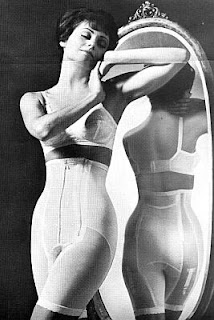To put it another way, for around £100 I got a dress, two skirts, two skirt suits, a pair of shorts and a jacket. Some were ready to wear but others needed a bit of attention from shortening a hem, taking in a bit here or chopping off a bit there.
I did most of the alterations very quickly and the items all worn, eliciting positive comments. However, one item has hung in the laundry room ever since, waiting for me to tackle it. I'm not sure what made me keep putting it off but I have finally done it and it was pretty simple.
But to roll back a bit, one thing was very noticeable when trying on suits from the 1960s, as both of the ones I bought were from this decade. When shopping I would normally pick a UK size 12 top and a UK size 10 bottom (although the fit can be variable as mentioned in my last post). However, I soon came to the conclusion that women in the '60s were a very different shape to women today.
One of the suits I bought was a UK size 14. The jacket style was boxy but, even so, still a little generous. However, it was nothing that a pair of simple darts in the back couldn't sort out. The skirt fitted perfectly on the waist but the hips stuck out a few centimetres each side of mine - clearly I'm no Christina Hendricks! Anyway, a quick whizz down the side seams with the sewing machine soon sorted out the hips and I was left with a perfectly fitting suit - 100% wool, made in London - for £25.
The other suit was a UK size 12 and the jacket fitted perfectly. However, the skirt waist was tiny. When I tried it on I couldn't do the zip up for the final 4cm or so. Mind you, if I moved the whole skirt up my body so that its waistline sat those 4cm above my own, what remained below those 4cm fitted very well indeed. I decided that rather than the conventional alteration of taking up the hem, I'd just chop the top off and make a new waist. It was this skirt that had hung in the laundry room for far too long. Today was the day I took it in hand and, as I said, it was surprisingly simple.
I grabbed a skirt from my wardrobe that has a similar shape and that I know fits well and lined the two up.
As you can see the blue vintage skirt is longer and (a lot) narrower at the waist than my modern skirt. But if you slide the modern skirt down, the two skirts do eventually line up at the top and, rather remarkably, along the sides. I know there is such a thing as a high waistline but on me this one would need to start to angle outwards to allow for my ribs!
I used this as my starting point for the alteration, drawing a line across the vintage skirt where my modern skirt waistline was.
And then I did the brave bit and just cut along the line.
Next, I took some bias binding from my sewing box and attached this to the right side of the vintage skirt at the newly cut waistline.
Then pressed it to the inside along the newly sewn line and then just slip-stitched it to the lining, catching the main blue fabric at points where the stitches wouldn't show on the right side, such as at the darts and seams.
Hey presto - I have a perfectly fitting new skirt (not to forget the matching jacket!) I just can't think why I didn't tackle this job sooner.
However, it still had me thinking about why women's waistlines were so tiny in the 1960s compared to nowadays. A friend put it down to all the sugar in modern diets, building up stomach fat, but I have to say I don't have a particularly large waistline. In fact, my normal problem buying trousers is that the waistlines are too big if they fit over my hips and thighs, which makes me think my waist is smaller than average for the times. Well, either that or my hips are particularly narrow.
So, I then began to think what women in the '60s wore under their skirts and I think I may be onto something. Look at these delightful items!
Fortunately, tiny waistlines or generous hips in vintage clothing don't seem to be anything that can't be overcome with the nifty use of a sewing machine in the year 2015!
Sadly, cutting off the waistline of the skirt removed the original label. Something which also made me smile.
Nowadays, a clothing label would be emphasising the amount of linen in the fabric, since we all seem to be about natural fibres these days; but in the 1960s it was all about the new technology. Could they have made the 67% any bigger? And I don't think I've ever seen the logo of a chemical company on a clothing label before. How times change.









